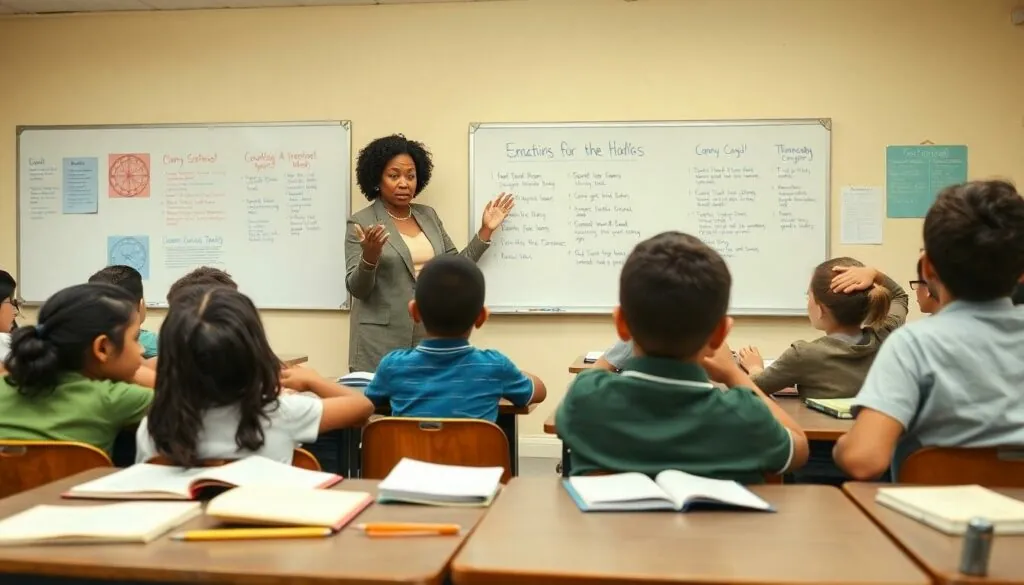Education today feels a bit like a game of Jenga—one wrong move and the whole thing could come crashing down. With budget cuts, outdated materials, and tech that sometimes feels more like a relic than a resource, students and teachers are navigating a challenging landscape. Who knew that learning could come with so many plot twists?
But wait, there’s more! As if juggling curriculum changes and testing pressures weren’t enough, the mental health of students is also at stake. It’s like trying to solve a Rubik’s Cube blindfolded—frustrating and confusing. In this article, we’ll dive into the quirky but serious problems plaguing education today, and maybe even crack a smile along the way. After all, who doesn’t love a little humor while tackling the tough stuff?
Table of Contents
ToggleOverview of Problems in Education Today
Budget cuts heavily impact educational institutions, limiting resources and staffing. Outdated materials detract from effective learning experiences. Many schools struggle to acquire adequate technology, leaving students and teachers at a disadvantage. Curriculum changes often create confusion, putting additional pressure on educators who strive to provide quality instruction.
Testing requirements add another layer of stress, focusing efforts on standardized scores rather than meaningful learning. High-stakes assessments can stifle creativity, reducing lessons to test preparation. Student mental health represents a critical issue, with increased anxiety and depression reported among learners.
Support systems for mental health frequently lack the necessary resources, making it challenging for students to access help. Engagement levels drop when classroom environments fail to meet diverse student needs. Teachers, too, face high burnout rates due to the demands of their roles, leading to a cycle of turnover that affects student relationships.
Equity remains a pressing concern, as underserved communities experience greater challenges, including fewer educational opportunities. Access to qualified teachers varies significantly, perpetuating achievement gaps. Thus, the educational landscape continues to evolve amid these significant challenges, demanding attention and innovative solutions.
Inequality in Access to Education

Inequality in education access remains a significant challenge, exacerbating achievement gaps among students. Numerous factors contribute to this pressing issue, particularly socioeconomic factors and geographic disparities.
Socioeconomic Factors
Socioeconomic status heavily influences educational access. Families with lower incomes often lack resources for tutoring, extracurricular activities, and technology. Students from disadvantaged backgrounds face higher dropout rates and limited college readiness. According to the National Center for Education Statistics, 31% of students from low-income households graduate high school compared to 83% of their wealthier peers. Educational funding predominantly comes from local taxes, further perpetuating inequities. Schools in low-income communities generally experience larger class sizes, fewer advanced courses, and inadequate facilities compared to wealthier districts.
Geographic Disparities
Geographic location plays a pivotal role in educational inequality. Urban, suburban, and rural areas each present unique challenges. Students in rural settings may contend with long travel distances to schools and limited access to advanced courses. The U.S. Department of Education reports that rural schools encounter significant teacher shortages, impacting educational quality. Conversely, urban schools often face overcrowding and higher dropout rates. Suburban schools typically boast better resources, reflecting significant discrepancies in funding and opportunities. Diverse geographic factors create varied learning environments, hindering equal access to quality education across the nation.
Quality of Educational Resources
Quality educational resources significantly impact learning experiences. Resource limitations hinder student engagement and effective instruction.
Teacher Training and Retention
Training for teachers often falls short. Many professionals lack access to ongoing professional development, which directly affects their teaching effectiveness. Retaining qualified educators poses another challenge. High burnout rates lead to increased turnover, disrupting student-teacher relationships. Studies show that consistent teacher presence enhances student performance. Addressing these concerns requires targeted investment in comprehensive training programs and supportive work environments.
School Infrastructure
Infrastructure quality varies widely across educational institutions. Many schools operate in outdated buildings, impacting student learning and safety. Inadequate facilities restrict access to necessary resources, including updated technology and learning materials. For example, schools lacking proper heating or cooling face attendance issues. Research highlights that modernized classrooms promote better engagement and academic success. Investing in educational infrastructure ensures all students can thrive in conducive learning environments.
Impact of Technology
Technology’s impact on education presents both opportunities and challenges. One major challenge stems from the digital divide, creating disparities in access to devices and the internet.
Digital Divide
Digital divide affects students’ ability to participate fully in modern education. Many students from low-income families lack reliable internet access, hindering their ability to engage with online resources. Nearly 18 million students in the U.S. experience limited or no access to essential technology, such as laptops and broadband. This lack of access restricts learning opportunities, widening the achievement gap. Schools in underserved communities often face additional hurdles, with funding inadequacies leading to outdated equipment. Addressing the digital divide requires significant investments and equitable policies to ensure all students can thrive in a technology-driven world.
Online Learning Challenges
Online learning introduces its own set of challenges that impact student success. Many students struggle with self-discipline and motivation in virtual environments, leading to disengagement. Research indicates that over 40% of students reported difficulty maintaining focus during online classes. Additionally, the lack of face-to-face interaction can hinder relationship-building between peers and teachers, crucial for effective learning. Inconsistent internet connectivity further complicates the situation, with students missing crucial lessons due to technical issues. Schools must develop comprehensive support systems that address these challenges, fostering an online learning environment that encourages engagement and collaboration.
Mental Health and Student Well-being
Mental health challenges significantly impact student well-being, affecting educational outcomes. Rising stress levels and anxiety persist among learners, with nearly 40% of students reporting feelings of anxiety on a regular basis. Academic pressures, social expectations, and the demand for high performance contribute to these feelings. Approximately 30% of high school students admit to experiencing persistent sadness or hopelessness, underscoring the critical need for mental health awareness.
Support systems play an essential role in addressing these mental health issues. Schools equipped with counseling services and mental health programs witness improved student engagement and academic performance. Effective support systems include trained counselors, peer support groups, and mental health resources that empower students. A comprehensive approach ensuring access to these resources fosters resilience among students, helping them to navigate academic and personal challenges.
Addressing the myriad challenges in education today requires a collective effort from policymakers, educators, and communities. The pressing issues of budget cuts, outdated materials, and inadequate technology must be tackled head-on to create a more equitable learning environment.
Moreover, prioritizing student mental health and providing robust support systems can foster resilience and engagement among learners. As the educational landscape evolves, innovative solutions and a commitment to equity will be essential in bridging the gaps that persist.
By working together to overcome these obstacles, it’s possible to cultivate a brighter future for all students, ensuring they have the resources and support needed to thrive.





